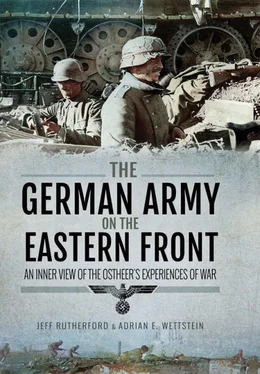This short discussion about the fuel columns not only provides a detailed view of the problem of integrating civilian vehicles into the army, but also indicates the wide variety of trucks in use, as well as the condition of many trucks on the eve of Barbarossa. The following section sums up all of the division’s problems, which were typical for the Eastern Army.
VI) In this context, the division again reported that beyond that [difficulties of supply], the same conditions apply with regard to the troops’ motor vehicle material, with the corresponding consequences for the motorized units’ operational readiness and the supply of the entire troops. In order to compensate for the shortages of the division’s equipment (only one motor vehicle workshop platoon, a horse drawn bakery company) and the lack of tonnage space in connection with the high combat equipment requirements of the troops from the beginning of the Eastern campaign with the enormously long supply routes, the division was forced from the very beginning to resort to using the total tonnage of the baggage train for supply, whether through central deployment by the division or by distributing its trucks for those lost by the second group [the food supply section of the battalions]. In order to meet the stringent demands of the almost uninterrupted marches and battles, it was to be expected that the troops had to abandon their baggage. It was later only possible for the division to supply the troops with the most essential luggage , that is to say that winter clothing left in Jassy was shipped to them. [20]
VII) The continuous change in the division’s subordination [21]may have been particularly disadvantageous in the motor vehicle supply with new allocations, spare parts and tires. In total, the division changed its subordination 25 times during the war. […]
IX) In summary, the reasons for the current extremely strained motor vehicle situation are as follows:
1) Shortcomings in the formation of the division: a horse drawn bakery company, assignment of only one motor vehicle workshop platoon, allocation [of] predominantly obsolete and exclusively commercial motor vehicle material, no towing-tractors.
2) Loss of tonnage and decline in the motor vehicles’ operational capacity due to the exchange of captured vehicles for German ones.
3) Failure of the refreshment period and in filling the vacancies before the Eastern campaign.
4) The enormously long and exceedingly bad advance and supply routes with their tremendous wear.
5) The heavy losses due to enemy action.
6) No allocations of motor vehicles corresponding to losses during the Eastern campaign.
7) Constant plummeting of the spare part supply and the lack of any local workshops.
If motor transportation situation was precarious at the beginning of the war in the east, it grew desperate in the following years. Not even the Panzer divisions, the German army’s spearheads, could escape the problem, as the following report of the 8th Panzer Division from 1943 indicates: [22]
The division submits below a report on the present vehicle situation:
I) The majority of the division’s vehicles date back to the time of formation in the year 1938. Insignificant reallocations later took place merely after the Polish campaign. Approximately 80% of the present vehicle stock dates back to this time. After the deployment of the division in the French, Yugoslavian, and Russian campaigns, general signs of fatigue now emerged in all of these vehicles as a result of their age, especially as the overloading of maintenance installations and difficulties in procurement of spare parts down to insignificant exceptions doesn’t allow for careful and complete overhauls.
Even the make-shift refreshment in spring 1943 in the Nevel-Gorodok area brought as a final result no improvement in the vehicle situation, as no complete overhauls could be carried out during this time. In addition, numerous vehicles that, to be sure, were to be repaired but not completely overhauled in the course of the refreshment broke down during the division’s deployment for bandit fighting during this same period of time. New vehicles, however, were not delivered to the division. After uninterrupted large scale combat since the beginning of July 1943, those still operational but very heavily used vehicles are no longer sufficient for their tasks.
II)
A) The Current Vehicle Situation
The number of the operational vehicles is excessively low in comparison to the establishment number because the establishment number also includes the vehicles that have to be sent to the Heimat for long-term repair (27%). A repair of these vehicles at the previous base in Minsk (moved on 20.10) was not practically possible due to the low capacity of the army motor vehicle park.
The number of vehicles in short-term repair (30%) will rather increase than decrease due to the over-taxing of the antiquated vehicle material.
B) Main Damage to the Operational and Short-Term Repair Vehicles
1) Approximately 50% of these vehicles require a replacement engine because cylinders and pistons are severely turned out and crankshafts and bearings are damaged.
2) Approximately 25% of the vehicles use up to 10 litres of motor oil per 100km.
3) Approximately 15% have damage to gear boxes to change speed and differential.
4) Approximately 20% have breaches in the frame, springs, and cranks.
5) Approximately 10% have broken drive shafts and half shafts.
A number of these vehicles (some 30%) that are necessary for the movement of the men, weapons and equipment must be moved by towing, which again has the consequence of an over-taxing of the still operational vehicles. Those vehicles that will be arriving from the Minsk repair station in the coming days (some 30) will only change the above-mentioned numbers minimally.
C) Procurement of Spare Parts
The well-known difficult replacement part situation has an especially negative impact on the division because the antiquated vehicles have become worn-out and therefore require replacement parts more frequently.
III)
A) For example, the shortage of vehicles has led to one Panzer Grenadier Regiment with a combat strength of 300 men of which 90 are immobile. At this time, 150 men in total from the combat strength are immobile.
B) The lack of any supply vehicles with the transfer of an armored halftrack company and 2 self-propelled light field howitzer batteries (Wespe) has an especially negative impact.
The most necessary vehicles for this must be provided from the available troop vehicles so that the mobility of this unit was further limited (see III A).
C) Due to the limited equipping with all-terrain vehicles – some 25% of the establishment number – the mobility of the division is further limited.
D) The available tonnage receives a further reduction as a consequence of the majority of the vehicles being able to carry at most only 75% of their nominal cargo load.
IV) In conclusion, one can say that the division can again be fully ready for action after the opportunity for a sufficient complete overhaul—with a correspondingly ample delivery of spare parts – and an allocation of around 25% new vehicles – in correspondence with the number in long-term repair (at this time already for many months). A quick remedy for the raising of operational ability can however only occur with the reallocation of transport room for ____ men, to at least make the current combat strength fully mobile.
One can clearly see in this report the dilemma between troop mobility and supply demands. This was intensified by the transferring of units without any supply vehicles, which then had to be drawn from combat units. The effects of an older vehicle park, which not only led to more breakdowns, but also reduced transport capacity while simultaneously increasing consumption of fuel and lubricants, was also made clear in the document. So the longer the war in the east lasted, the more German units had to rely on horse-drawn supply. The additional requirement of manpower could be only satisfied due to massive influx of Hilfswilligen or Hiwis, Soviet soldiers who more or less voluntarily fought for the German side. This issue will be discussed in more detail in chapters 5and 6.
Читать дальше







![John Stieber - Against the Odds - Survival on the Russian Front 1944-1945 [2nd Edition]](/books/405234/john-stieber-against-the-odds-survival-on-the-russian-front-1944-1945-2nd-edition-thumb.webp)





